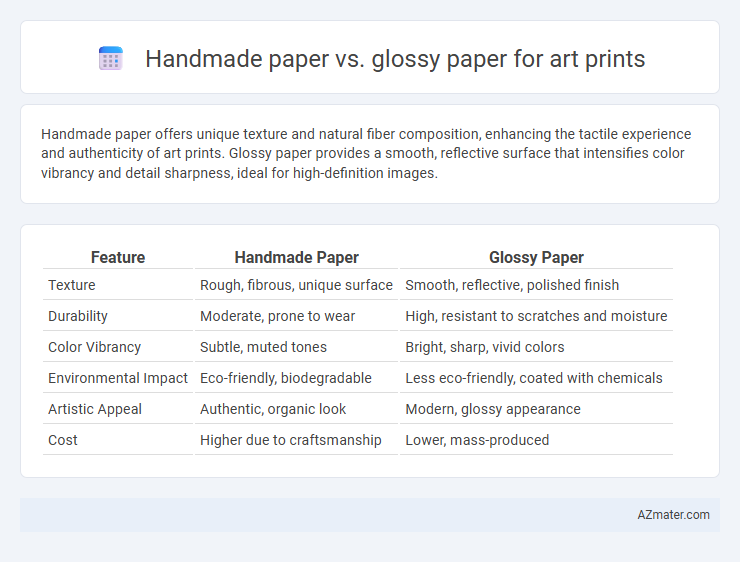Handmade paper offers unique texture and natural fiber composition, enhancing the tactile experience and authenticity of art prints. Glossy paper provides a smooth, reflective surface that intensifies color vibrancy and detail sharpness, ideal for high-definition images.
Table of Comparison
| Feature | Handmade Paper | Glossy Paper |
|---|---|---|
| Texture | Rough, fibrous, unique surface | Smooth, reflective, polished finish |
| Durability | Moderate, prone to wear | High, resistant to scratches and moisture |
| Color Vibrancy | Subtle, muted tones | Bright, sharp, vivid colors |
| Environmental Impact | Eco-friendly, biodegradable | Less eco-friendly, coated with chemicals |
| Artistic Appeal | Authentic, organic look | Modern, glossy appearance |
| Cost | Higher due to craftsmanship | Lower, mass-produced |
Introduction to Art Print Paper Choices
Handmade paper offers unique texture and organic fibers that enhance the tactile experience of art prints, making each piece distinct and visually rich. Glossy paper provides a smooth, reflective surface that intensifies colors and sharpness, ideal for vibrant and detailed reproductions. Artists must weigh the matte, natural appeal of handmade paper against the bright, high-contrast finish of glossy paper to align with their artistic vision and display context.
What is Handmade Paper?
Handmade paper is crafted using traditional techniques that involve manual lifting of pulp from a vat, creating unique textures and irregularities ideal for art prints. This paper absorbs ink differently than glossy paper, offering a matte finish that enhances the depth and detail of watercolor, charcoal, and pencil artworks. Its organic fibers and natural finish provide a tactile quality that complements fine art, making it favored for limited edition prints and gallery presentations.
What is Glossy Paper?
Glossy paper is a smooth, reflective surface often used for art prints to enhance color vibrancy and detail sharpness. Its coated finish allows for high ink absorption and a shiny appearance, making images appear more vivid and polished compared to handmade paper. While glossy paper offers durability and a professional look, it can produce glare and fingerprints that may affect artwork viewing.
Texture and Surface Differences
Handmade paper features a rough, fibrous texture with natural irregularities that enhance tactile depth and absorb ink unevenly, creating a unique, organic appearance ideal for fine art prints seeking authenticity. Glossy paper offers a smooth, reflective surface with a high sheen that intensifies color vibrancy and sharpness, resulting in crisp, polished prints favored for photographic and commercial art. The choice between the two depends on desired visual effects and texture, with handmade paper emphasizing texture and subtlety, while glossy paper prioritizes color saturation and detail clarity.
Color Vibrancy and Print Quality
Handmade paper offers a natural texture that enhances color vibrancy by absorbing ink differently, resulting in a matte finish with subtle, muted tones ideal for artistic prints emphasizing depth and nuance. Glossy paper, with its smooth, reflective surface, amplifies color intensity and sharpness, providing high contrast and vibrant saturation, perfect for prints requiring crisp detail and vivid imagery. Print quality on handmade paper favors tactile and organic aesthetics, while glossy paper excels in producing bright, precise, and visually striking artwork.
Artistic Expression and Style
Handmade paper offers a unique texture and natural irregularities that enhance the tactile quality and depth of art prints, making each piece distinct and expressive. In contrast, glossy paper delivers sharp, vibrant colors with a smooth, reflective surface, ideal for artworks requiring high contrast and fine detail. Artists seeking to emphasize organic feel and subtlety often prefer handmade paper, while those aiming for crisp, polished visuals choose glossy paper to amplify their artistic style.
Durability and Longevity
Handmade paper offers superior durability due to its natural fibers and thick texture, providing excellent resistance to aging and yellowing, making it ideal for long-lasting art prints. Glossy paper, while vibrant and sharp in color reproduction, tends to be more susceptible to scratches and fading over time, especially when exposed to light and moisture. For art prints requiring maximum longevity, handmade paper is preferred for its archival quality and ability to maintain integrity over decades.
Environmental Impact and Sustainability
Handmade paper offers superior environmental benefits due to its use of recycled fibers and minimal chemical processing, significantly reducing waste and pollution. Glossy paper, often coated with plastic or chemical layers, poses challenges in recyclability and contributes to higher carbon emissions during production. For sustainable art prints, handmade paper supports eco-friendly practices by enhancing biodegradability and lowering overall ecological footprints.
Cost Comparison: Handmade vs Glossy Paper
Handmade paper typically incurs higher production costs due to labor-intensive processes and natural materials, making it more expensive than glossy paper, which is mass-produced using automated techniques. Glossy paper benefits from economies of scale, resulting in lower unit prices and more cost-effective options for large-volume art prints. Artists must weigh the premium price of handmade paper against its unique texture and aesthetic value versus the budget-friendly, vibrant finish offered by glossy paper.
Choosing the Best Paper for Your Art Prints
Handmade paper offers a textured, organic surface that enhances the depth and character of art prints, making it ideal for artists seeking a unique, tactile quality and natural fibers that absorb ink richly. Glossy paper provides a smooth, reflective finish that amplifies color vibrancy and sharpness, perfect for prints requiring high detail and bright, vivid tones. Selecting the best paper depends on the desired aesthetic and durability, with handmade paper suited for traditional, textured artworks and glossy paper preferred for vibrant, photographic-quality prints.

Infographic: Handmade paper vs Glossy paper for Art print
 azmater.com
azmater.com